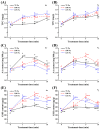Effect of Glow Discharge Cold Plasma Treatment on the Physicochemical Properties and Antioxidant Capacity of Maize
- PMID: 40282714
- PMCID: PMC12025849
- DOI: 10.3390/foods14081312
Effect of Glow Discharge Cold Plasma Treatment on the Physicochemical Properties and Antioxidant Capacity of Maize
Abstract
This study evaluated the effect of cold plasma (CP) on the physicochemical properties and antioxidant capacity of maize. CP treatments were performed using a glow discharge, applying argon and/or nitrogen at 50 W, with different working pressures (75, 100, and 125 Pa) and exposure times (1, 5, and 10 min). The maize samples were analyzed before and after treatments for color, fatty acid value (FAV), malondialdehyde content, superoxide dismutase and catalase activities, total phenol content (TPC), ascorbic acid content, reduced glutathione content, and antioxidant activity. The antioxidant activity was further evaluated during storage (25 °C for 180 days). After treatments, color parameters (brightness, yellowness, and saturation) showed measurable enhancement, while FAV and malondialdehyde content were significantly reduced by 14.95-56.37% and 11.38-43.71%, respectively. The optimal treatment conditions (100 Pa working pressure and 5 min exposure) maximized antioxidant enzyme activities and bioactive compound levels, accompanied by substantial increases in TPC. Under these conditions, maize samples had the highest organic radical scavenging capacities (DPPH), reaching 1.31-fold (argon plasma) and 1.25-fold (nitrogen plasma) that of untreated sample. During storage, all samples subjected to the optimal combined treatment exhibited higher DPPH radical scavenging capacity and ferric reducing antioxidant potential, along with lower FAVs and malondialdehyde contents compared to the untreated sample. Additionally, the DPPH radical scavenging capacity exhibited statistically inverse correlations with both FAV (r2 = -0.49) and malondialdehyde content (r2 = -0.15), as quantified through Pearson correlation analysis. These findings indicated that glow discharge cold plasma is a potentially effective non-thermal processing technique to enhance bioactive compound accumulation and antioxidant enzyme activity for preserving maize's physicochemical properties, with possible use in the food industry for sustainable grain preservation strategies, particularly in delaying oxidative deterioration.
Keywords: antioxidant enzymes; bioactive compounds; color property; enhancing effect; fatty acid; malondialdehyde; storage.
Conflict of interest statement
The authors declare no conflicts of interest.
Figures







Similar articles
-
Effect of cold-pressed and normal centrifugal juicing on quality attributes of fresh juices: do cold-pressed juices harbor a superior nutritional quality and antioxidant capacity?Heliyon. 2019 Jun 18;5(6):e01917. doi: 10.1016/j.heliyon.2019.e01917. eCollection 2019 Jun. Heliyon. 2019. PMID: 31286079 Free PMC article.
-
Effect of thermal treatment on physicochemical and antioxidant properties of honey.Heliyon. 2019 Jun 26;5(6):e01894. doi: 10.1016/j.heliyon.2019.e01894. eCollection 2019 Jun. Heliyon. 2019. PMID: 31304409 Free PMC article.
-
Improving blueberry cold storage quality: the effect of preharvest hexanal application on chilling injuries and antioxidant defense mechanisms.J Sci Food Agric. 2024 Nov;104(14):8837-8851. doi: 10.1002/jsfa.13710. Epub 2024 Jul 10. J Sci Food Agric. 2024. PMID: 38985128
-
A combination of acidic electrolyzed water with modified atmosphere packaging improves quality of jujube during cold storage by enhancing antioxidant activity.J Food Sci. 2023 May;88(5):1849-1864. doi: 10.1111/1750-3841.16539. Epub 2023 Mar 27. J Food Sci. 2023. PMID: 36973916
-
Surveying the utilization of cold plasma and plasma-activated water on food pigments, bioactive compounds, enzymes, vitamins, fatty acid, and essential oils: Considerations, mechanisms, and future trends.Food Chem X. 2025 May 11;28:102509. doi: 10.1016/j.fochx.2025.102509. eCollection 2025 May. Food Chem X. 2025. PMID: 40486063 Free PMC article. Review.
Cited by
-
Microbial Decontamination of Fresh-Cut Carrots via Cold Atmospheric Plasma Treatment: Effect on Physicochemical and Nutritional Properties During Storage.Foods. 2025 May 1;14(9):1599. doi: 10.3390/foods14091599. Foods. 2025. PMID: 40361681 Free PMC article.
References
-
- Faostat Online Database. [(accessed on 24 February 2025)]. Available online: https://www.fao.org/faostat/zh/#data/QCL/visualize.
-
- Solon J.G., Killeen S. Decontamination and sterilization. Surgery. 2019;37:51–57.
-
- Sánchez-Rodríguez A.R., Rey M.D., Nechate-Drif H., Castillejo M.Á., Jorrín-Novo J.V., Torrent J., del Campillo M.C., Sacristán D. Combining P and Zn fertilization to enhance yield and grain quality in maize grown on Mediterranean soils. Sci. Rep. 2021;11:7427. doi: 10.1038/s41598-021-86766-2. - DOI - PMC - PubMed
Grants and funding
LinkOut - more resources
Full Text Sources
Miscellaneous

